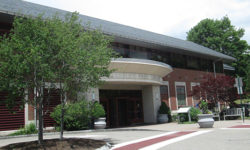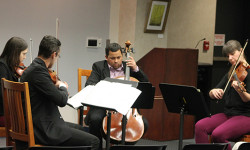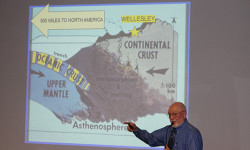By Katrina Margolis
Hometown Weekly Reporter
There is wildlife all around us which, regardless of its ubiquitousness, remains unseen. One of the most elusive of these wild creatures is the owl. There are owls local to Wellesley that the majority of Wellesley residents have never heard, nevertheless seen. Marcia and Mark Wilson are breaking down the walls of mystery that come with some of these lesser-seen animals through their program, Eyes on Owls. Last Wednesday, the Wilsons did two separate presentations at the Wellesley Library for children and adults alike.
The couple began the educational program in 1994 and it’s been going strong ever since. “This is the fourth time that we’ve been invited to the library,” Marcia Wilson said. With them, they brought five owls and a “mystery bird,” later revealed to be a Peregrine Falcon.
Mark Wilson explained how they are able to keep these birds: “In this country, it’s against the law to have wild animals as pets. The reason we can keep these owls is that all of them either have an injury or a disability that keeps them from surviving on their own,” he said. “We have to have special permits from Mass Wildlife and from other states that we go into to keep these birds, we’re their caretakers.”
“Along with those permits come some rules we have to follow,” Marcia added. “We can’t let any of you touch or hold the owls. I’ll get you nice and close, though. Remember, they all have a reason that they can’t take care of themselves, so we’ll tell you their stories, and then we’ll tell you how their kind lives in the wild.” Before presenting the actual owls, Marcia and Mark read “Owl Babies,” a children’s book with beautiful illustrations of some of the very owls they would be presenting that evening. The overall program is aimed at children, however adults can learn just as much.
The first owl they brought out was a screech owl. “Screech owls don’t screech – surprise! They make a nice little whinnying sound,” Marcia said. After some facts about the owl, they asked if there were any questions, to which a dozen hands shot up, inquiring about the feeding of the birds, what seasons they come out during, and what their sleeping patterns are.
The program not only filled in some gaps in people’s knowledge about local wildlife, but inspired the inquisitiveness it takes to learn even more.






















